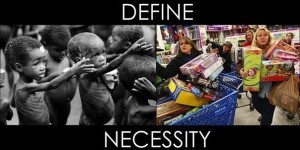
The photo to the right, and various others similar to it, have been doing the rounds this holiday season.
The main reason for a photo like this is to create strong, visceral feelings. These photos are meant to make us realize our own excess in comparison to so many people’s impoverishment. They’re designed to make you feel something – most likely guilt.
When viewing them in their most altruistic light, they might effect some change in your life, through your giving and/or spending habits. They’re designed to evoke sympathy for the poor, starving children in the picture. To guilt you into action.
And they often work.
How many telethons, photo campaigns and commercials have we seen in the geographical North with just such images on them? Millions of dollars are raised each year through these methods.
Surely if they worked as a long term solution to the problem, we would have seen them once and that would have been enough.
But every year, you see the same telethon, every Red Nose Day, every BBC Children in Need campaign the same images and stories are shared, tears are shed and money is raised. Only to be done again in another 12 short months.
It’s very easy to see the same thing with our youth. Parents say ‘eat your peas – there are starving children in Africa’ or we take our youth on a mission trip or community service trip and see them cry and come home radically changed for a few weeks, or best case scenario a few months, but gradually over time they slip back into their ‘old ways’ until the next trip.
I am generalizing a little – there are some youth that are so profoundly changed during their time abroad or just by reading a story that they make a decision and make a real difference in the lives of others. But for the majority, the former is much more likely to reflect their true experiences.
This is because those images and experiences create sympathy rather than empathy. We need to focus on helping our youth develop empathy. There are many people who see sympathy and empathy as synonyms.
However, sympathy actually relates to the heart feelings about something, and we all know (looking back on our ‘lifelong loves’ when we were 13, 15, 16, 17, 19, 20, 22, 23…..) that the heart is fickle. When you feel sympathy, you feel bad for someone else, but you aren’t able to really ‘experience’ their pain on any level that is going to cause you to change your behavior for the long term. When we show these images to youth it’s a shock, and when the shock wears off they’re left with their old habits that they fall back into.
Empathy means that you get it in your head, you can see yourself in their situation and understand how truly awful it is, you understand the feelings on an intellectual level and therefore are able to internalize the feelings, and use them to effect change.
When this happens with our youth, rather than just feeling bad, they can understand what kinds of commonalities they share with the other person. They’re able to ‘walk a mile in their shoes’ and when they do this it causes long term change to their behaviors.
When you’re able to help a youth see that the child or teen in the picture likes the same sports or plays the same games as they do but is also suffering from the loss of their mother to HIV, you can help them develop empathy. By helping them identify their own feelings of deepest loss, relate that back to how this youth might be feeling and help them create an action plan to make a change.
Activities like the 30-hour famine can help create empathy because youth get to truly feel what hunger feels like. Is it the same as the famine that is actually going on in many places around the world? No, of course not. But it will begin to provide an intellectual understanding of what hunger is, rather than just an emotional response to a photo.
Question: Do you think empathy is important in youth work, or is sympathy enough? We’d love to hear your thoughts in the comments below.
You can also connect with us by:
- Signing up to receive our posts via email
- Following us on Twitter
- Liking us on Facebook
- Signing up to our RSS feed